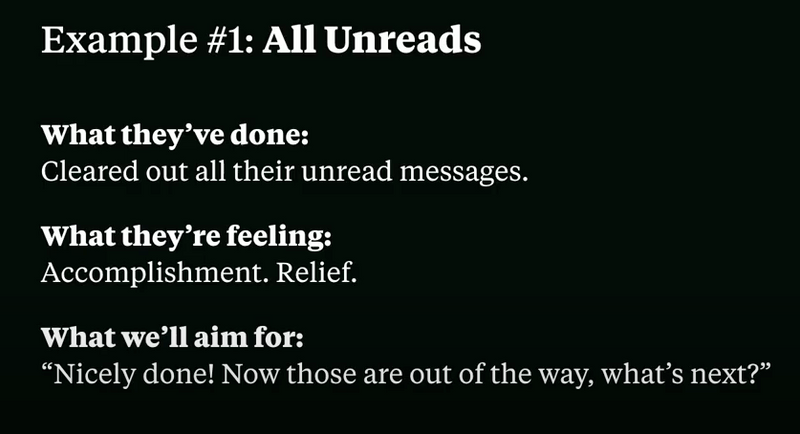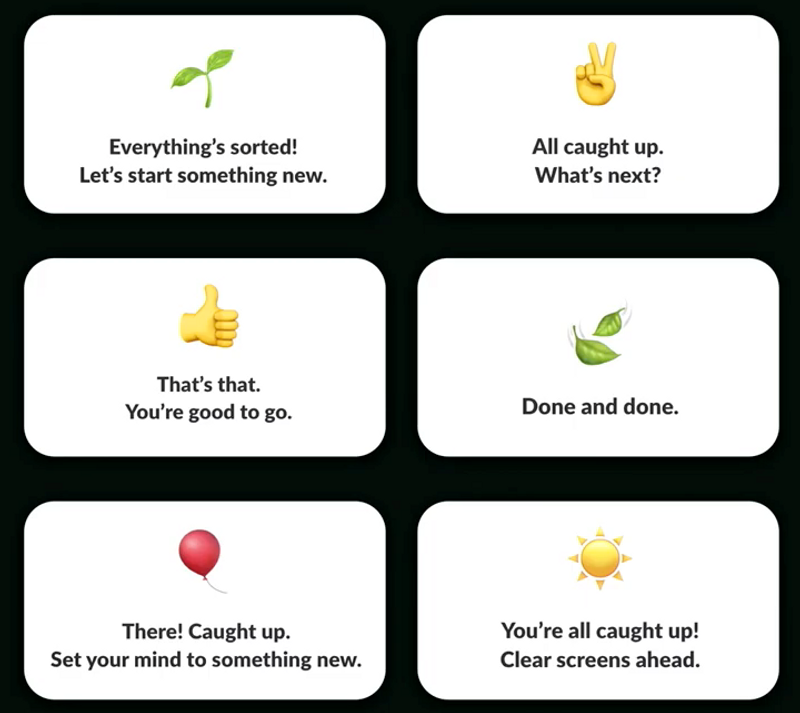What I Learned About UX Writing From a British Prog Drummer and David Lynch
There are so many brilliantly written articles about UX Writing out there so I decided to take a look at it from a more personal point of view.
10 min read
·
By Erik Mathisen
·
December 6, 2020

"“I mean it like it is, like it sounds.”"
Most fans of Twin Peaks will probably remember this line, even though it is overshadowed by a significant number of other quotes from TP. If you have not not seen it yet, go stream that masterpiece right now. #spoilers
Why is this particular line so important? Because it is part of the keychain needed to unlock the many abstract concepts Lynch and Mark Frost presents to us, the viewers. The line is from the episode where Mike enters the dream of agent Cooper, revealing clues about Laura Palmers killer. What I find interesting about this line is its deceptive yet clear intention. The viewer is told what to pay attention to, but the dreamy context suggest we might be deceived.
But some things are just what it is, how it sounds.
The mind is a detective
Intuition guides us, one screen at the time.
For 10 years, I was writing for various advertising companies. My job was to craft words to lure the reader into whatever brand-context I was working on at that time, often with the help of abstractions of concepts, allegories, and other creative tools. It taught me a lot about perception and how I could, very subtly, plant hints for the viewer to decipher the brand message. But most importantly, it made me understand how the brain systematically create mental concepts to percieve and understand the world around it. Words play a crucial part in this process. An incredible 50 % of all words we hear cannot be understood out of context (when presented in isolation). By using concepts, the brain learns to categorize and make sense of all this variable noisy flow of information.
How ironic, you might think, that I found clarity in one of the most surreal dreamscapes ever to air on TV in our lifetime. To me, that’s the beauty of inspiration. It rises to our consciousness like wild salmon jumping upstream a river, striving to get a foothold in our mind amidst all the noise.
Like Lynch and Frost, I left the keys in plain sight for the audience to discover and interpret. Creative advertising requires just that, an idea we, the creators, code, and then let the audience decode. But UX Writing very often requires quite the opposite. You must write it like it is.
The sound of clarity
It has always been a beautiful mystery to me, how clarity has the power to shape us. How it informs us simply by being less intrusive or more truthful.\ To me clarity is not the equivalent of writing short and efficient sentences. It can be about that, but not just that. Clarity is about finding the true essence of whatever you’re trying to convey. It’s what will make your followers believe you or not and go where you’re guiding them. Or not.
"Just do it
I have a dream
Fire, walk with me"
But clarity is also this
The real challenge is to fuse the two worlds into one. For that to happen you’ll need to sit down, relax, focus, open your mind and just…
…listen
In an interview with Vanity Fair, Jony Ive, former Chief Design Officer of Apple, said that Steve Jobs had an amazing ability to focus. He managed to eliminate the inevitable noise surrounding any world-changing project and devote all his attention to making it the next big thing.
Regardless of age, title and which floor you work on, there is a valuable lesson to be learned from this, Focus is needed to build great stuff, but it also essential for knowing when your brand needs to speak up. Or when to shut up.
Understanding when to do what requires the ability to listen. I will listen to what the customer says about their experience. Pay attention to what the designers have to say about their intentions and challenges. Concentrate as programmers show me the project’s specifics and possibilities.
Jobs did this and was not afraid to change his mind should it benefit his creative singularity. It takes a great amount of willpower to let go of your own ideas.
Enough about Jobs, tell us about the drummer
In an interview with Drumeo, drummer Gavin Harrison, known for his musicality and passion for rhythmic design, shared his tips and methods for coming up with tasteful drum parts, improving your creativity, and your general mindset when playing the drums. While talking about his references from his younger days, he begins talking about drummers who play with time.
“You’ve probably heard this expression before, but everybody’s job in the band is to play in time, but it’s the drummer’s job to make the time interesting. So, you don’t have to just play, say, if the first verse just needs two and four on the hi-hat, you don’t have to just sit there going… …what I would do is listen to the vocalist and look for spaces to do small musical embellishments. Put it in the right place, and it’s beautiful. Do it every bar, and it’s horrible.”
This is precisely what UX Writers should do (among many other important things). Listen to the project as a whole, look for spaces in between code, design, text, menus, forms — literally every point of interaction — to create something that elevates the project, and therefore the brand. Band. You know what I mean. And yes, I consider UX Writing to be an essential part of building and/or maintaining a brand.
Words are like ghost notes providing subtle dynamics to the sonic scenery. They will make people feel something.
Be part of their feelings
Humans like to be liked. Brands too. Therefore we make and effort to portray ourselves, man and brand, in a way that will serve as purposeful and friendly for our peers. From a brand point of view we would very much like people to feel what we want them to feel about us. This is usually where marketing says “we got this”. And they probably do. Persuasion is needed to increase awareness and market shares. But what happens after we get their attention?
This is where guidance and clarity is provided and needed, not juicy headlines and rethorical tropes. Now it’s time to go with (and steer) the flow.
Some people understand this process intuitively and how to utilize it in many different ways. In a talk at Design Matters 2019, Senior Product Writer at Slack Andrew Schmidt shared insight from Slacks early days on how language could be a tool for identifying “bad” design, and how they discovered when to inject brand personality and how to do it. They came up with a very simple and interesting rule:
Never try to make the user feelInstead, look for the feelings they’re already having.\ And just be part of those.
👇🏻


The delicate sound of raging customers
I believe Slack is on the right path when it comes to how they percieve UX Writing. They have chosen a much less intrusive approach in a world where our minds are bombarded with emotional hooks ready to be reeled in. But for enhancing your UX Writing, I think being subtle and aware (but don’t forget to surprise once in a while) will take you far.
Is your brands presence needed for solving this particular task?\ Or is it better to get out of the way for a bit?\ Treat words in the same way designers treat white space.
The invisible rudder
My family owns a summer cabin near the ocean. In my younger days, I would cruise around in our family’s tiny motorboat. That was when I learned the concept of a rudder, a gentle device for navigating smoothly across the sea. This information suddenly reappeared a few years ago when I was writing about ergonomic seating. The company I wrote for had designed a new office chair that kept the person in it slightly moving while sitting down. One of them sat in the chair and used their feet to move around. Seeing this, I suggested to the designers that the feet act as a rudder to navigate the body. According to them, this was a perfect description of what they had accomplished.
I looked. I listened. And I found the embellishment I was looking for.
In this ocean of information we’re slowly drowning in, I like to think of microcopy as an invisible rudder for our intuition. It’s there to guide you through interactive waters, shallow or deep, without you seeing it. If you can see the rudder, you’ve probably hit bottom, and then you have to slow down to understand the situation. When designing interactivity, people crave fluidity. Like in a musical piece that captivates us or in a movie that enthralls us with great dialogue and scenery. Or even a game like Red Dead Redemption 2 whose job is to help us navigate 60+ hours of content while keeping us immersed in their universe. Well played.
Creativity, meet functionality
Our understanding of the world is layered in mental concepts. Everything can be stripped down to its very basic components. Even what we know to be basic components has its own basic components. By understanding this, one becomes humble when faced with the task of understanding complex matters. Or answering complicated questions.
Whenever I write, my goal is always to find the simplest version of the truth intended. By truth, I mean the pieces of information I relay to people who desire an outcome of some sort, typically in an app or landing page. Sometimes I need to let function dictate what I write; other times, it feels like a good time to sparkle with some creativity.
Bill Bernbach, a legendary copywriter responsible for the famous Think Small ads for Volkswagen, once said that creativity is the intangible thing that makes the difference. It’s just something that feels right. Right? But at the same time, creativity is an extra layer for people to decode and make sense of. What I’m saying is being creative for creativity’s sake is not enough. It has to add meaning or value.
Bill Bernbach also said that "advertising is fundamentally persuasion, and persuasion happens to be not a science but an art". This is also something I hold to be true. Although much progress has been made in science since this quote was published, I believe it is just as accurate today. What’s new is that originality is being copied much faster. And mediocrity shines like never before, radiating in front of the good stuff.
"So, don’t feel bad about procrastinating when you need to write. Humans put the whole thing of for a couple of hundred thousand years. By a conservative estimate, we’ve had writing for 4 % of the time we’ve been humans. Chatting is easy, writing is an arduous chore.
— Erika Hall, Conversational Design"
Where does this leave us?
This post is by no means an answer to anything. That is for you to decide. Whatever I write stems from a place of truth and many late night solo ventures into the self. If it somehow resonates with someone in some way, I’m happy.
One thing I do know from watching David Lynch’s work, is that I come to the same conclusion, time and time again, and that is that closure is never what we really want. For better or worse, life is just more interesting when everything is ever-changing.
So, stay curious. Embrace clarity. Worship creativity.
Through the darkness of future’s past,
The magician longs to see.
One chants out between two worlds…
“Fire… walk with me.”
We lived among the people.
I think you say, convenience store.
We lived above it.
I mean it like it is… like it sounds.
Sources
How Emotions Are Made, by Lisa Feldman Barrett
Andrew Schmidt, Senior Product Writer for Slack
Twin Peaks Season 1, Created by David Lynch and Mark Frost
And everything else my senses absorb when I’m not aware 🧠